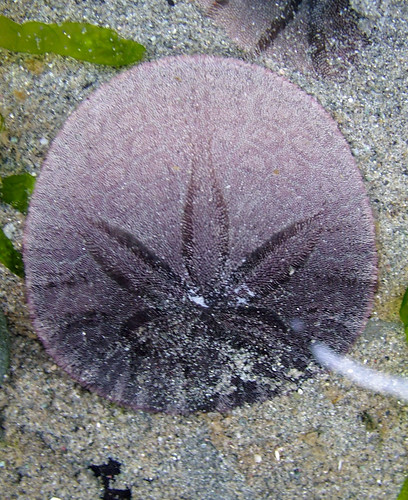 |
| photo by Cheryl Moorehead |
GASP! Who would have thought that there could be a lot of questionable and apparently, conflicting information on the Internet!!!
A lot of info on these animals may be somewhat basic to the well-travelled marine biologist, but maybe not so much to the curious or intrigued student or aspiring beach scholar! So, I thought today I would explain some basic sand dollars "stuff" and clarify some of the mystery.
FIRST-some basic introductions........
So, everyone is at least passingly familiar with sand dollars.
Those funny "dollar shaped shells" that one often finds walking along a beach down by the sea shore. How often have you seen this familiar sight?
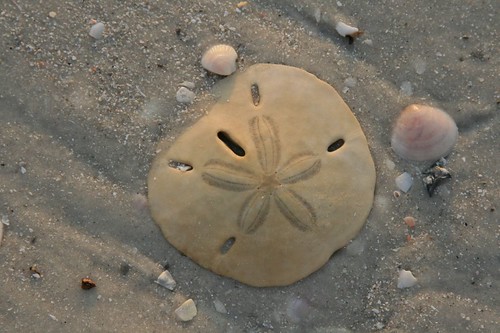 |
| photo by Jdigeronimo66 |
So, let's clarify this first- and foremost.
Sand dollars are the skeletons from ANIMALS.
Sand dollars are the skeletons from ANIMALS.
Specifically, they are Echinoderms, which is the group that includes starfish, sea cucumbers, crinoids, and of course... sea urchins.
When sand dollars are alive, they are covered with a "fuzz" and look like this..
 |
| photo by Cheryl Moorehead |
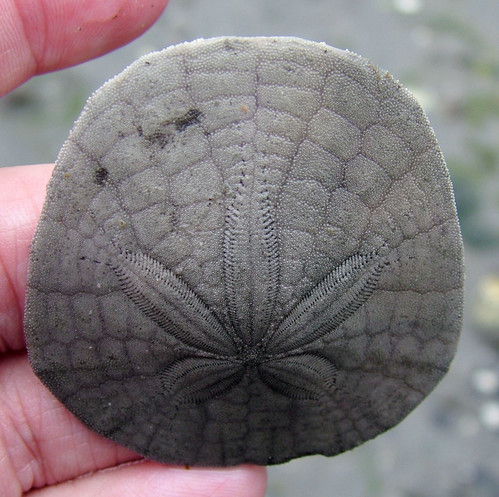 |
| photo by Cheryl Moorehead |
The "fuzz" are actually the SPINES on a very strange looking sea urchin!
Sand dollars are ANIMALS, specifically they are sea urchins! (Class Echinoidea)
Sand dollars belong to a group known as the Clypeasteroida. There are some 75 genera of sand dollars, 29 living and 49 fossil (following Mooi 1989) with quite a few species.
Most sand dollars live in tropical shallow-water places (e.g., Africa, Singapore, Indonesia, the Bahamas, etc) but a few do live in cold to temperate waters (e.g., Dendraster excentricus on the west coast of North America)
Sand dollars are NOT shells. Proper shells are deposited by organisms (such as mollusks) and are external to an animal's body.
And while we're discussing this, please note that sand dollars have ENDOSKELETONS rather than exoskeletons. That is to say, they are covered by skin and are considered "inside" the animal's body. A Sand dollar skeleton is known as a TEST.
So What makes a sand dollar a sea urchin??
Typically, we think of conventional sea urchins as looking kind of like this...
A big sized, ROUND ball covered by spines. These sea urchins often graze on algae an live out in the open on reefs or kelp beds. Often in large numbers.
These have historically been referred to as "Regular" urchins. They have long, well-developed Spines and well-developed teeth as part of a elaborate jaw called Aristotle's Lantern. You can see all of these features in this video...
Now, in CONTRAST....
Sand dollars are members of a specialized sub-group of sea urchins that are often referred to as the "Irregular Urchins" These urchins differ quite a bit from the so-called "Regular" urchins because they show a suite of adaptations to living in sandy/muddy/ bottoms!
In "irregular" sea urchins.. specifically sand dollars the following changes occur...
1. The body (i.e., the test) changes from round and radial (in regulars) to flat and bilateral (in irregulars) like this...
(photo by Electropod)
to something more like this, which you'll note has both a left and a right side..
(photo by Avian-Cetacean Press)
2. Spines in "regular" urchins are usually elongate and pointed. But those in "irregular urchins" (esp. sand dollars) are short and specially modified to help in moving sediment..like so...
Here's what a single spine looks like under SEM close up. Not pointed but with a more blunt tip...
3. The special jaw apparatus "Aristotle's Lantern" is modified!
In a "regular" sea urchin, the Aristotle's Lantern or Jaw (seen here from the inside with the rest of the body removed) is used to feed on algae and its positioned as such..
 Here's a neat video that shows the oral surface-and you can see the jaw's teeth in action emerging from the mouth
Here's a neat video that shows the oral surface-and you can see the jaw's teeth in action emerging from the mouth
In contrast..here's the jaw (aka the Aristotle's Lantern) from a sand dollar. The top has been cut away and you can see it from the inside (mouth facing bottom). Its been modified into basically, a "crushing mill" for grinding up sand and so forth.
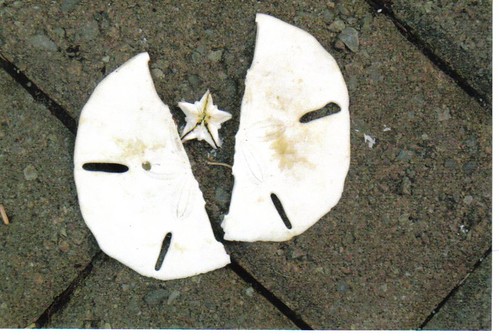
The individual pieces of the jaw (aka the Aristotle's Lantern -which are often broken) is probably what you hear rattling around inside when you pick one up off the beach...
Plus, you'll often see it used in "inspirational" art and the famous "Legend of the Sand Dollar" postcards and related paraphenalia like this one...
 The "doves of peace" are the broken fragments of the Aristotle's Lantern, i.e, the jaw the animal used to crush and grind sand. The "Star of Bethlehem" is a neatly dissected, complete jaw from the inside of the sand dollar.
The "doves of peace" are the broken fragments of the Aristotle's Lantern, i.e, the jaw the animal used to crush and grind sand. The "Star of Bethlehem" is a neatly dissected, complete jaw from the inside of the sand dollar.
5. The Body shape has changed as the body as evolved from that of a "regular" to an "irregular" urchin.
The above tree is used from Mooi, 1990 in Paleobiology!
The overall shape has seen a flattening out in the upper right part of the tree where we see sand dollars relative to their more globose relatives.
If you want to read an excellent paper on the evolution of sand dollars, I would suggest checking out this paper by Rich Mooi in Paleobiology. Its from 1990 but has many interesting bits!
Finally..
Here's a kind of loosey goosey summary diagram by Echinoblog Art Dept!
The "Regular" urchin or ancestor:
1. Grazes on algae or other items. Many live out in the open. Several species live on reefs or on kelp beds.
2. Test (the body) is round, globose and pentameral (that is -radial in 5 directions)
3. Spines are elongate.
4. The Aristotle's Lantern is larger and generally, is used to graze off bottoms
BUT if you compare the SAME features in Sand dollars and other "Irregular" urchins...
1. Lives on sandy or other bottoms with lots of sediments or mud.
2. Test is often flattened, and bilaterally symmetrical
3. Spines are shorted and appear "fuzzy" on the surface
4. The Aristotle's Lantern is flattened and specialized for grinding sand.
Remember that the above differences are morphological ADAPTATIONS that are specifically tied to living and digging through the sandy, bottom habitat.
The spines and Aristotle's Lantern see clear modification for a specific lifestyle... In many ways, this is a beautiful example of how morphology has changed as adaptation to a specific life mode.
Sand dollars have many NEAT adaptations to living on sandy bottoms.
Sand dollars are basically, REALLY strange sea urchins! Please make a note of it!
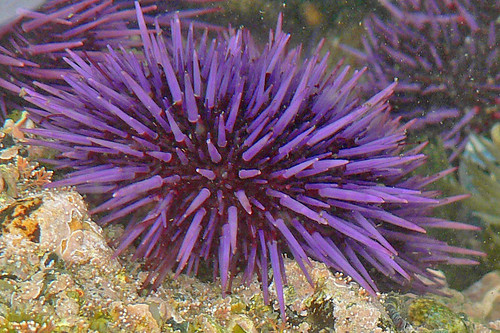

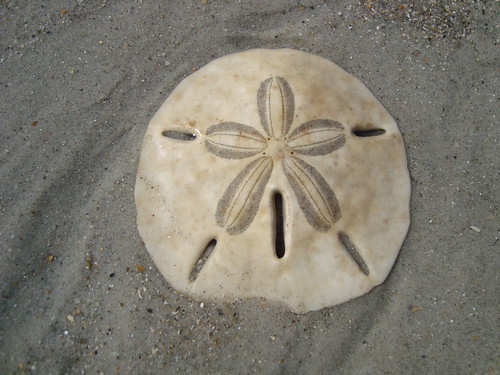




Excellent info!
ReplyDeleteAre they poisonous
DeleteThank you. That was very interesting and informative.
DeleteYes. But why the scary music in the sand dollar time lapse movie?
ReplyDeleteImagine you were a grain of sand, it'd be pretty damn scary.... Nuff said....
DeleteThank you, great information. I really loved the videos as well.
ReplyDeleteFound sand dollars at gulf shores, alabama. They have what looks like legs all along the sand dollar, what type of sand dollar is this? I never saw these before, always find sand dollars w/o legs.
DeleteI found a sand dollar fossil behind my house in Puerto Rico. I would like you to see it. Where can I send you the photos?
ReplyDeleteis this one? Mellita quinquesperforata is one of the more commonly encountered species in that area:
ReplyDeletehttp://www.echinoids.nl/Echinoids/Mellita-quinquesperforata/Mellita-quinquesperforata.htm
feel free to host it on a photohost and post in the comments!
Mine is like the first photo you have on this page. I sent the photos on the link you gave me.
ReplyDeleteThanks for sharing this info. My son just got a couple of fossil urchins for christmas and we couldn't figure out why they looked more like sand dollars.
ReplyDeleteVery impressed with your researched knowledge. I learned a great deal and you answered my question...thank you
ReplyDeletebsebyalGlad to know we didn't take home a live one. Thanks.
ReplyDeleteExcellent blog! I stumbled across it in my search to learn how sand dollars breathe. I have discovered they breathe by diffusion through tube feet. But i've seen differing answers online to whether they can breathe out of water when they're on the sand at low tide. Can you help me with this?
ReplyDeleteI would think that gas exchange works best if there is water present, so they would need to be submerged. Its not likely that they will do well out of water for very long.
ReplyDeletevery informative. well done. I learned quite a bit about these creatures which I've been curious about. thank you.
ReplyDeleteWe were at beach this weekend and found 3 things that look kinda like sand dollars but they are not flat.... Is this a sand dollar or something else??? I have only ever seen the flat ones before now.... I told my kids I would help them find out what they are but have not found a picture on Internet any where.
ReplyDeleteHi Diane,
ReplyDeleteif you are on the SE coast of the US, then what you probably saw was the sea biscuit, Clypeaster
which looks like this
http://science.kennesaw.edu/~jdirnber/MarBioBelize/Lectures/MarineInverts10/Clypeast.jpg
these have a body form which is much more swollen. Hope that helps!
Thank you so much ChrisM you have been very helpful and I appreciate the info very much!!!
ReplyDeleteIn Wiltshire,England the fossils are collected on the Downs. 100 years ago my father was collecting "Shepherds Crowns", I still have them. Obviously it is a very long time since Wiltshire was under the sea.
ReplyDeleteHello! I wanted to ask about how to take care of a sand dollar? I already know from your info that if has hair then it's alive. But I found it at the beach, and I don't know if it's alive or dead! If it's alive, how do I take care of it? I'm so confused!
ReplyDeleteHi Kiara
ReplyDeleteIf you find a living sand dollar, I would just return it to the ocean and/or leave it where you found it. Sand dollars require food taken from the sand, and it generally requires a lot of special care to keep them in aquaria since the nutrients aren't really available from easily obtained sources.
Hi Chris. Very good scientific information complemented by interesting vídeos. I am portuguese but I live in Brazil where I met sand dollars for 1st time and I am in love, despiste being agronomic engineer. The ocean is fascinating. Thanks for sharing.
ReplyDeleteAwesome info! Without you, I would have failed my Science test!
ReplyDeleteWOO! congrats!
ReplyDeleteThis is a great site - thank you so much for your time to present this information. It is just what I need to explain about sand dollars when I give him the 3 shells Ibrought home from the northern California coast. No other site came anywhere close to being this interesting and informative.
ReplyDeletethanks for the kind words. Glad to be of help!
ReplyDeleteThanks also had difficulty finding what I had found so now I guess I can stop calling it a sand dollar and refer to it as a sea biscuit. Very fragile and thicker than a dollar, thought it may be a relative of sea urchin. Have lived on beaches in Tasmania, Australia all my life but found my first sea biscuit at age fifty on a tidal river estuary and more recently closer to my home town on a very long sandy beach.
ReplyDeleteGreat clarification on a beautiful creature I think I was calling a shell all my life-sorry! won't anymore, but what are the 3-4 rectangular cutouts in some sand dollar species from and for? Could you explain what the pretty design is from again?
ReplyDeleteHi,
ReplyDeleteI think you mean the holes and etc.? These are called lunules. I explain them here:
http://echinoblog.blogspot.com/2009/01/what-are-those-holes-in-sand-dollars.html
if you meant something else, lmk and I will try to explain.
What a beautiful bit of education I just had!
ReplyDeleteWhat a great bit of education I just had! Thanks
ReplyDeleteSand dollas for life, beaches!
ReplyDeleteBBeaches be all irregular... real urchins where it at!
ReplyDelete-Urchin76
@urchin76 Oh no u didn't! Don't make me smack u in yo Aristotle ' lantern, suck a fool!
Deletei actuslly found a few urchin shells and sanddollars they were both dead but the sand dlollars broke when we got home but we were very careful with the urchin shells my mom actually ouund the urchin shells because she said they were floating around above the water
ReplyDeleteI found so many sand dollars on a Flat beach. One was really large & Carried it upside down. Eventually my hand was stained all yellow. I put it back in the ocean. IS this a defense mechanism?
ReplyDeleteWe found a lot of Sand Dollars in Ft Myers Beach and our hands were stained yellow also. I had never experienced this before. Would be interested to find out why this happens also.
DeleteIts unclear to me what such a coloration would result from, but I am unaware of sand dollars having any sort of chemical defenses.
ReplyDeleteI'm afraid you'll have to be a bit clearer. "Legs" could mean many things including the spines on the surface. A picture would also be helpful.
ReplyDeleteThank you for such an excellent page! Good work!!
ReplyDeleteI was wondering in the past how big have sand dollars been recording getting to in size? Like an ancient ancestor of the giants could there be one of the sand dollar?
ReplyDeleteThanks for your question. There is a pretty good fossil record for sand dollars-usually early Cenozoic (post-dinosaurs). But the largest I've seen any of them get is about the size of a medium sized dinner plate.
ReplyDeleteWow thanks for the answer, that big, cool.
ReplyDeleteHello, this was a fascinating article! I am visiting Nicaragua, where they call the sand dollars estrellas del mar, or stars of the sea. A google search for any such thing turns up starfish, so I'll consider these disk shaped creatures sand dollars.
ReplyDeleteAs we walk along the beach, we see several that have recently washed ashore. If they are flipped upside down, we have been turning them over gently, at which time they scurry quickly under the sand. Many will say it is better to leave them alone, but I hate the thought of them scorching to death slowly just because of an unfortunate ride in a wave.
Please let me know if they are doomed to a certain untimely death if upside down on the beach, or if they are still all right if they are upside down. I don't want to mess with nature, but just as I would try to save a creature drowning or something, I would like to do a good deed for these lovely animals as well.
Greetings Becky,
ReplyDeleteI appreciate your concerns. to be honest I'd need to see exactly what you are talking about to be sure but yes..if you are turning them back over and they are buyring themselves back into the sand then I'd approve. I don't know if they are "doomed" but taken at face value it sounds as if you are helping them. Since one probably cannot help ALL the animals that are like this, your behavior reflects more on you than on any direct widespread effect on the population..so I would wish you my best for your kind efforts.
best,
Chris
Thank you so much for your encouraging response, Chris. We are certainly not able to walk the beach constantly looking for creatures to assist, but it is nice to hear that when we are able to help, we are likely doing that, and not harming the course of nature.
ReplyDeleteMuchas gracias,
Becky
Thank you for the commentary on sand dollars. A friend recently brought me about 40 of the tiny variety that were part of more than one hundred they encountered on the beach. I've developed a special love for the tiny creatures and watch for these irregular urchins on the beach. I'd like to link a blog post about my preoccupation with them to this post so my readers can read more if they're interested.
ReplyDeleteHi there
ReplyDeleteCan sand dollars be found in Australia? Would like to find out soon, as I am going to the beach in a few weeks
Thanks!
Indeed they can. But I'm not sure if they are as abundant since they can occur in deeper water. Note that sometimes, finding sand dollars in shops does not guarantee they are local. Many are imported from America.
ReplyDeletenice
ReplyDeleteI would like to know how and why you can tell when the urchins are safe to take. I do not want to ever take live urchins, but would like to take dead when free diving.
ReplyDeleteThanks!
So long as you find the skeletons white and missing all of the spines they should be fine. Living urchins, including sea urchins, still have all their spines attached. Sand dollars would still have a "fuzzy" feeling to them rather than being smooth.
ReplyDeletei was in Cuba the other day when i came across a sea biscuit...it is 4x5 didnt know what it was thought it was a fat sand dollar.Is this considered large?
ReplyDeleteI read on another sight that the yellow coloration left on your fingers is confirmation that the sand dollar is alive. Apparently not an unusual occurance.
ReplyDeleteThis is a great post, thanx!
ReplyDeleteSo, my question for the day is: how do they think? Do they have some sort of brain? Like, how do they know to dig in the sand to avoid predators? Do they recognize predators when they're nearby? If so, how? Smell? Sound?
I'm really intrigued by these guys, having found literally scores of them, all diff. sizes, this year on the shores of Coronado.
Thanx in advance for any info.
BeachComberBuff
They don't have any well developed neural centers (i.e. no brain) and aren't known to be behaviorally complex. Most of their behavior is pretty much dictated by their basic functions-eat. spawn, etc. They can sense food in the water with strong chemoreception and presumably do the same with predators.
ReplyDeletethanks for your questions!
I have a few sand dollars found in Ghana, Africa. They are a turquoise color and have many indentations along one side. I've identified as Rotulidae, can you tell me about them?
ReplyDeletePlease check my post about them from awhile back: http://echinoblog.blogspot.fr/2014/07/rotulid-sand-dollars-weird-mysterious.html
ReplyDeleteTo the best of my knowledge, no sand dollars are known to be poisonous.
ReplyDeleteHi I was wondering where I could get my fossil sand dollar identified? I found this fossil 50 years ago in South Australia. I am leaning towards a cassiduioios from the information you have supplied.
ReplyDeletehi,
ReplyDeleteIts not clear exactly where you are locatesd but you might be able to get some assistance from a paleontology or geology department at your local university or natural history museum. There are also several facebook groups which have citizen scientist/amateur fossil hobbyists.
good luck!
Thanks Chris for a very informative blog which is still attracting comments 5 years on. I had never seen these sand dollars before until today. I found a heap of endoskeletons on horseshoe bay beach on magnetic island on the great barrier reef, off the coast from Townsville,QLD, Australia.These ones are 'penta' shaped and seem to have an a mix of regular and irregular features... which I guess makes then irregular... thnx
ReplyDeleteAre sand dollars edible?
ReplyDeleteI assume you mean by humans? And so I would say mostly not. Sand dollar body structure is primarily skeleton and spines. I suppose its possible that someone might have developed a taste for the uni (gonads) the way other sea urchins are eaten but that has yet to be demonstrated as anything more than a chance irregularity.
ReplyDeleteinteresting question. thanks!
Chris. I'm a 4th year sociology student in Canada. I think I understand everything politics/society. I would love to email you. I've found a new interest in sea erchrins.
ReplyDeleteThis comment has been removed by a blog administrator.
ReplyDeleteI dint see you mention they are Located all so on the east coast of Canada
ReplyDeleteLike in the Bay Of Fundy, I always find many sand dollars there.
Excellent information! I have a recent obsession with sand dollars! It is so difficult to find reliable information on them! Thank you. I have read that there are 29 living species from around the world, but I cannot find a list of them anywhere. Do you have a good resource? Love your blog and than you for the good info!
ReplyDeletethere are many sources..but I'm not sure how many are present in an easy to read format. will need to check..
ReplyDeleteI have gray sand dollars? with no holes. Is it a sand dollar. It does have the star marking on the top
ReplyDeleteThanks so much Chris! I’m 77 and just learning about these magical creatures. I will pass this along to my kids so these beauties become more than collection pieces. It is fascinating to understand and value the endoskelaton.
ReplyDeleteYou are quite welcome! thank you!
ReplyDelete